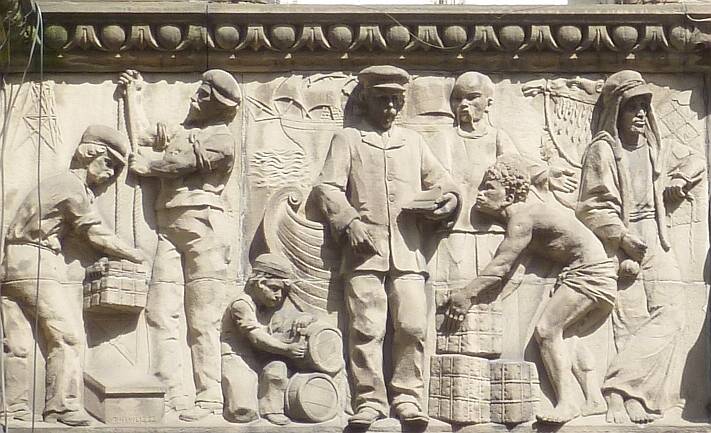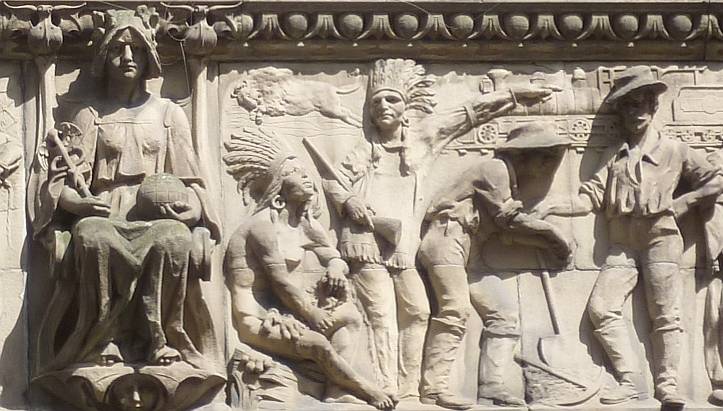
Architectural Sculpture on Abtech House, 18 Park Row, Leeds (former West Riding Union Bank building). Joseph Thewlis ( 1862-1921) Architects Oliver and Dodgshun, 1900). Sandstone (above red Swedish granite). c. 1900. Thewlis, the son of a factory engine-stoker, was a native of Leeds who became a stonemason and sculptor, and traded as Thewlis & Co. from about 1900 to 1911. This four-storey building is located on what The Builder described in 1896 as "the Pall-Mall of Leeds" (qtd. Leach et al. 438) — a street that still carries memories of the city's commercial heyday. It has a distinctive ground floor with interlaced strapwork decorating the red granite. The fine full-length frieze just above it shows Minerva, in her role of Goddess of Commerce, on her throne with figures on each side depicting the bank's trading connections with various parts of the world.

Thewlis has adopted one of the popular approaches to architectural sculpture on commercial buildings, with realistic scenes representing the bank's agents engaged in their transactions (see also The Royal Exchange in London). Left: on this side of Minerva are seven figures. Two workmen on the left are unloading a ship (notice the crane in the upper lefthand corner), and a boy is crouching” by some barrels, the agent in the middle is holding pen and accounts. On the right are activities at the other end of the trading equation. An African is lifting a bale, a Chinese man is gesticulating (perhaps driving a bargain), and someone in Middle Eastern costume is carrying a basket on his shoulder. Behind a ship's prow can be seen a sailing ship. Though Minerva herself is stylised and Art Nouveau-ish, it is a wonderfully lively scene, full of naturalistic details: notice the men's moustaches, and the thickset docker with his cap to one side.

In this panel, Thewlis shows the bank's commercial interests in the American railroad, with two very fine American Indians in their headdresses, one holding a rifle and pointing at the train in the background. Two American railroad workers are doing the hard graft, with their implements. Behind and above the Indians can be seen a very fine, lively buffalo, apparently fleeing from the train. Again, a lively, realistic and this time perhaps rather humorous scene.
Photographs and caption by Jacqueline Banerjee. You may use this image without prior permission for any scholarly or educational purpose as long as you (1) credit the photographer and (2) link your document to this URL in a web document or cite the Victorian Web in a print one.]
Related Material
- Frieze on the Royal Exchange, London.
- Railways and Shipping on Britannia House, Green Arbour Court, London
- Ship and locomotive on the Canadian Pacific Building, Trafalgar Square, London
Bibliography
"Joseph Thewlis." Mapping the Practice and Profession of Sculpture in Britain & Ireland, 181-1951. Web. 20 July 2011.
Leach, Peter, Nikolaus Pevsner and othersYorkshire West Riding: Leeds, Bradford and the North. The Buildings of England series. New Haven & London: Yale University Press, 2009.
Last modified 27 April 2018